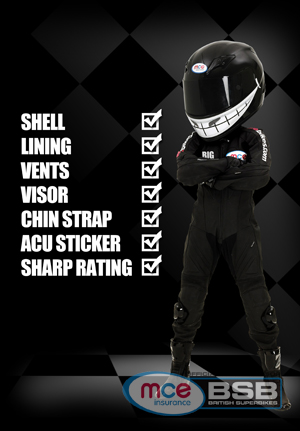How to find a bargain crash helmet

Given the monstrous size of my lid, I more than most bikers should know that your crash helmet is by far your most important bit of protective riding gear. It's the item that is most likely to save your life in the event of a crash and can also say a lot about you to other bikers. Take mine for example - my helmet is big, black, shiny, and has a toothy smile. It's the single feature above all others that people recognise me for as 'Big Ed'. What does your crash helmet say about you?
Whether you're looking for a big brand name with a budget price or a cut price custom paint scheme, you need to know what to look for when shopping for a bargain crash helmet!
Shell - The outer layer of a helmet is made of one of three materials; Polycarbonate (an injected thermoplastic which is tough and heavy), Glass Reinforced Plastic (more expensive but tough and lightweight) or the most expensive helmets, which are manufactured using Carbon Fibre Composites, making them ultra light.
Lining - All helmets will use expanded polystyrene to absorb impact. Cutting weight, more expensive helmets will use varying densities whilst still providing decent protection. The soft liner is there to ensure a good fit. Better quality helmets will use softer, non-sweat, hypoallergenic materials. The best of the best will have removable, machine washable liners.
Vents - These are crucial for keeping your head cool in the summer and you visor clear of condensation fog in the winter! However vents can also create noise... especially if prominently raised. Check that they can be operated with gloved hands.
Visor - Needs to be stiff and secure to protect your face if you land facedown. The majority are removable and tints can be applied to them. Before trying this yourself, ensure you are happy with how to do this. You can go wild with an oil effect tint or keep it sensible with an anti-fog coating.
Chin Strap - Many budget lids use seatbelt-type quick-release catches. These need to be adjusted regularly, to ensure they're secure. Most high-end helmets use Double D-ring fasteners, which are correctly adjusted each time they are fastened.
ACU approved sticker - It's only essential if you're planning on doing track days as you will need this for when the stewards ask to take a peek during sign up.
SHARP rating - Helping riders choose protective head gear, the government introduced the SHARP helmet testing scheme. The scheme is not without its critics, but it does provide a consistent and impartial assessment of the protective capacity of helmets, from a minimum of 1* to a maximum of 5* (at least 3* is advised!).
17.10.12 - Big Ed





